Random Reviews: The Mask
A surprisingly engaging exploration of vigilante wish fulfillment, The Mask provides humanity, hilarity, and horror in equal doses
—by Nathan on September 26, 2025—
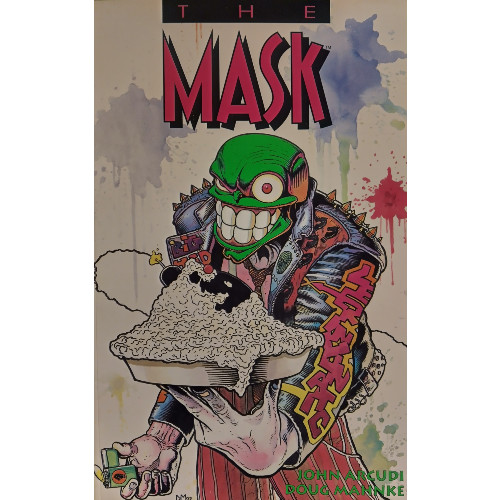
I assume, when most people hear of this "Mask" character or see the comic, the first thing that comes to their minds is the 1994 movie starring Jim Carrey. I have never seen that film, nor was I aware for the longest time that it was based on a comic, though from what I can tell, the film really is its own animal. A box office success with Carrey as a virtual unknown at the time and starring Cameron Diaz in her first professional acting role, The Mask (the movie) seems more of a fun comedic film than a genuine attempt at bringing a comic to life, beholden to the original narrative's premise but not feeling like a panel-by-panel recreation.
I will fully admit that I have seen the sequel, Son of Mask, and I am well aware of its universally deplored status. I did see that film as a child, however, and even if the kid version of me enjoyed the low brow slapstick shtick of the film, I most likely wouldn't find much to enjoy these days.
So let's stick with the original comic.
I'm writing this review now because John Arcudi contributed several issues to the latter half of Marvel's Warlock and the Infinity Watch series, which I recently read, reviewed, and found I generally appreciated more than the Jim Starlin issues! Arcudi took the seeds Starlin planted and grew them in interesting ways; under him, the series was still imperfect, but characters were given at least some development and strong moments and exchanges stood out. I had somewhat remembered Arcudi's name associated with another 90s comic; a little digging reminded me that comic was Dark Horse's The Mask.
And so here we are.
Having not seen the first film, I am reviewing this without the added effort of comparing the source material to the movie. I am looking at this volume as a collection of comics only, exploring how the green-faced fiend works within the pages.
The Mask
Writer: John Arcudi
Penciler: Doug Mahnke
Inker: Doug Mahnke
Colorists: Doug Mahnke and Matt Webb
Letterers: Pat Brosseau and David Jackson
Issues: The Mask #0-4
Volume Publication Date: August 1993
Issue Publication Dates: August 1991-October 1991, December 1991
Publisher: Dark Horse Comics
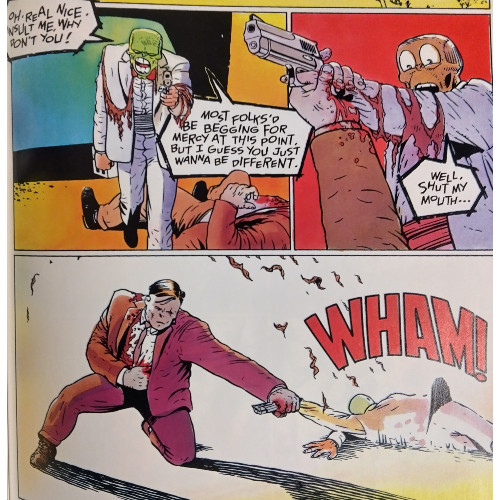
Reading this volume, I could not help but think about the scene in Captain America: The First Avenger where Dr. Abraham Erskine explains his super soldier formula to Steve Rogers. As Erskine tells the future Captain America, "The serum amplifies everything that is inside. So, good becomes great. Bad becomes worse." This is why, he explains, Johann Schmidt became the Red Skull and why he believes Rogers will become a great man.
The titular McGuffin in Arcudi and Mahnke's series must work under very similar principals, though it seems you'd have to go quite a ways to find anyone "good" who'd become "great" while wearing this mask.
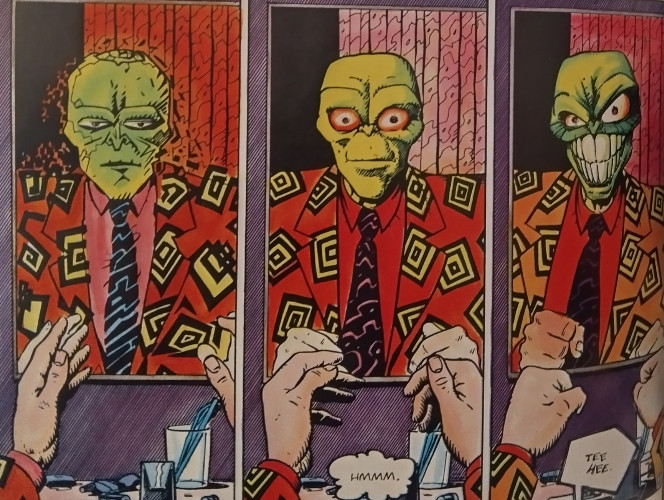
I first read this limited series, plus a few sequels, in a digital format, and I walked away with a sour taste in my mouth concerning the first few issues, all of which are reprinted here. Originally appearing in a limited series published by Dark Horse called Mayhem, The Mask's mask first latches onto perpetual loser Stanley Ipkiss, who transforms from a spindly geek into the living embodiment of a Looney Tunes cartoon, capable of pulling random weapons out of anywhere, practically invincible, and none too fond of laws either manmade or physical. Though Carrey plays a version of Ipkiss in the movie, less-than-lovable loser Stanley here is a temporary fixture in the comic, and based on my original opinion, it was "good riddance" from me as soon as he got out of the picture. Empowered by the mask, Stanley becomes a cross between what Dark Horse publisher (and original co-creator of the Mask character) Mike Richardson calls in an introduction to this volume "[a] combination between Tex Avery and The Terminator!" He's just downright horrible, and I think I felt taken aback by just how fanatical and violent Stanley becomes while wearing the mask.
Upon a re-read, I realized that this is exactly the point Arcudi is trying to make.
The Mask is an experiment in vigilante escapism, in bestowing upon Stanley and other characters the means to explore their wildest ambitions and embrace their darkest urges with wholehearted, reckless abandon, regardless of what those ambitions and urges are and who they may hurt or obliterate along the way. If the absolute cornball sight of Stanley having shoved a muffler down the throat of a local mechanic both disturbs and impresses you, good. That's supposed to happen. Stanley, who feels like a nobody of a person, finds freedom to explore his darkest leanings with the mask. A scene early in the comic has Stanley imagine all the horrible ways he'd maim and murder a motorcycle gang that humiliates him…and this is before he tries on the mask. Once he becomes the Mask, Stanley exacts revenge pretty much as he imagines it, leaving the gang and their garage a smoking wreck for the cops. Stanley, as with other characters, already has a very human, very broken, very corrupt bent to his thoughts...and the mask allows the opportunity to lean into that bent in a way Stanley the local yokel never would on his cognizance.
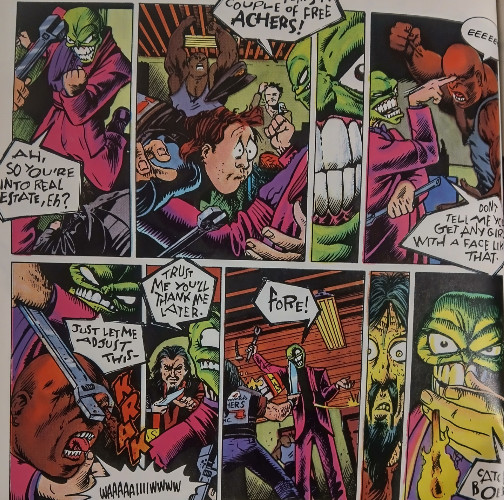
Arcudi and Mahnke indulge in the violence–sometimes as outlandish as death-by-muffler and other times as horrific as bullets and bombs–to showcase not just the hilarity of their hero's imperviousness but to make the squirm-worthy coats of blood and guts slightly more palpable. Lean heavily one way, and you get a comic that's about making death as realistic as it can be for the sheer brutality of it; lean the other, and you have a comic that makes even the most gruesomely fatal kinds of violence amusing at worst, kinda funny at best. There's nothing inherently funny about a guy getting a muffler shoved down his windpipe, but once you see the exaggeration of it all, you can't help but engage in a chuckle or two, same as you would if Bugs Bunny force fed Daffy Duck or Elmer Fudd random car parts. We're talking the dark days of comics here, where creators from all corners indulged in brutal violence, so to have a comic which almost ridicules the trend by bear-hugging the insanity of it feels refreshing.
Yet the exaggeration placed upon the violence is indicative of the actual dark leanings of the characters wearing the mask, whose number is not limited to only Stanley. His girlfriend Kathy and Lieutenant Mitch Kellaway also feel the overpowering influence of the mask, and it's actually Kellaway who becomes the series' main character and, arguably, its protagonist. Kathy, like Stanley, uses the mask selfishly, but under its influence, Kellaway finds his sense of justice as a police officer vaulted to the nth degree. Already a little testy with authority during the day-to-day, Kellaway becomes a whole new individual by night, the mask providing him the excuse to take down criminals the "system" doesn't have enough power to incarcerate, even if corruption didn't linger through the offices. As the vigilante the public dubbed "Big Head" when Stanley began terrorizing folks, Kellaway dishes out his grim brand of justice with a good dose of humor and whimsy that characters such as the Punisher, Wolverine, or Spawn sorely lacked.
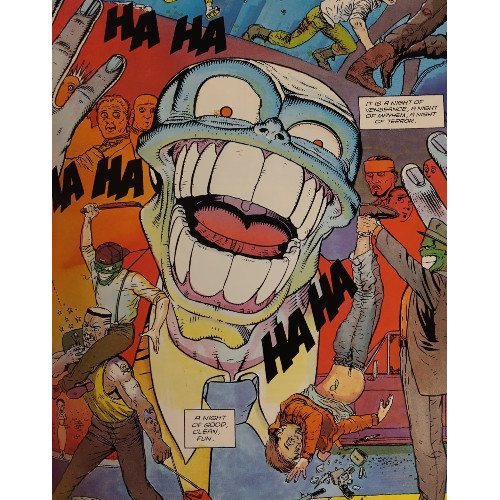
Arcudi wisely presents the process of wearing the mask as a two-way street for these characters, almost in a "the Mask gives and the Mask takes away" sense. The violence, I can absolutely see through Stanley's pent up rage, Kellaway's sense of justice, and even Kathy's own irritations. The lowercase-"m" mask allows them freedom and ability to indulge their passions, and subtly, Arcudi does indicate the process has lingering effects, from Stanley's impulsive need to have the mask after initially wearing it, to Kathy's guilt over her actions while wearing the mask, to Kellaway's increased obstinate behavior with his superiors. It almost seems to work in a similar vein to a symbiote, increasing a character's strength while also playing havoc with their psyche. And, naturally, the mask seems to play havoc with its wearer's intentions as well–Kellaway may want to clean up the streets, but under the influence of the mask, that mission becomes the bloodiest clean-up the streets have ever seen.
I will admit that not every aspect of the Mask's identity or personality dovetails nicely with the "mask amplifies what's inside our protagonists" theme. The inanity and immaturity with which folks wearing the mask behave outside of the violence–the goofy voice, the exaggerated personality, the penchant for slapstick–does not necessarily seem based in the characters themselves but feel like a side effect of wearing the mask. In other words, don't let a reference to Frank Sinatra make you believe Kellaway is a fan of the singer; it's possible, but it doesn't need to be true for the Mask's personality to come through. Once I realized this, part of me wished Arcudi had let the Mask express some other character-focused traits, but if a good chunk of the character's existence is based on the mask switching between different "owners," I see where Arcudi decided to maintain an even tone across people, even if certain aspects of the mask's influence seem distinct to individual wearers.
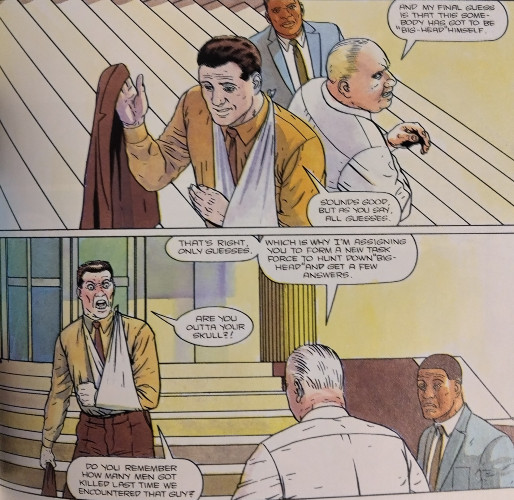
As an illustrator, Doug Mahnke shows considerable improvement between the Mayhem issues and the first Mask limited series. I'm not sure what experience he had prior to helping develop this character, but there's a simplicity to the Mayhem issues which makes the outrageous anti-hero feel plopped into a newspaper strip at times. Once we've reached the original limited series, however, Mahnke pours more detail into his work, almost as if he's taken to the concept more seriously. The physical gags are still present, yet they're blended with more realistic characters that make the gags and bizarre physicality of the Mask lean towards horror at times. The Mask peels his "face" off after disguising himself as someone else; beads of sweat dot a nervous man's brow; even acts of violence have somewhat less of an extrapolated feel than they did in the Mayhem issues (no one's killed by a car muffler, for instance). It's impressive growth, and it makes the themes and characters of that initial series feel appropriately serious.
On second try, this first volume of The Mask holds up better than my initial reading. The story is not just an excuse to pump out ridiculous levels of violence and stylize it with cartoonishness just for a laugh. There's amusement, for sure, but the rampaging and roughness is intended to point back to our characters. The mask (the object) takes people and turns them into extreme versions of themselves, versions who act with abandon. The skinny nerd who becomes a vengeful killer, the frustrated girlfriend who vents her annoyance, the cop who becomes a vigilante. There's decent depth here, and though I remember that depth somewhat bubbling up in the sequels I read, we'll just have to see in future posts how other people transform when they become this green, grinning ghoul generator of garish, ghastly, gruesome gore.